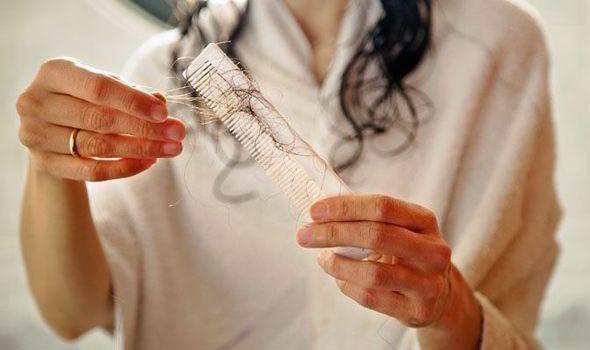For information on hair loss treatments go to Hair Loss Remedies and Treatments or you can also navigate this site by using the links on the left. You might also like to check out the products we have that conceal hair loss at Hair Loss Concealers and Hair Enhancers.
General Information On Hair Loss
 Do you feel that you are the only one losing hair? You’re not! The most common form of hair loss, Androgenic Alopecia, or pattern baldness, is experiences by over 50 of men. For women androgenic alopecia occurs between 20-40% of the general female population. You’re not alone, but actually in the majority.
Do you feel that you are the only one losing hair? You’re not! The most common form of hair loss, Androgenic Alopecia, or pattern baldness, is experiences by over 50 of men. For women androgenic alopecia occurs between 20-40% of the general female population. You’re not alone, but actually in the majority.
Androgenic alopecia develops when the hair follicle (the place under the skin where hair grows from) experiences a reduction in size, as well as a time reduction in the active growth phase. this translates into a simple fact: more and more of the hair follicles will spend time in the resting state where hair is shed once the state is completed. Fortunately, androgenic alopecia does not develop in all hair follicles at the same time. This is why some part of the scalp seems to be losing more hair than the other.
What causes androgenic alopecia? As boys grow up, their hair follicles are exposed to androgen (any hormone that controls the appearance and development of masculine characteristics) that their body has synthesized. Once hair follicles are exposed to androgen, they become “androgen sensitive” and androgenic alopecia can develop latter in time. Stopping the hair follicles from interacting with androgens seems to prohibit any chance of androgenic alopecia development.
To put it in a more detailed explanation there are two types of androgen that need to be considered: testosterone and DHT (dihydrotestosterone). An enzyme called 5-alpha-reductase converts testosterone to DHT. Once DHT is formed, it has the ability to bind to any androgen receptor in hair follicles. This binding reduces follicle activity, shrinks the hair follicle which in turn slows the hair growth cycle, reduces the diameter of the hair shaft and over times hair growth ceases.
For females, the mechanism of the condition is similar to that of the males. the source of the androgen is the combined activity of the ovaries and the adrenal glands. Hair loss in women can many times be directly related to pregnancy or menopause and their effects.
Why do some people seem to have more extensive hair loss than others? recent research suggest that the answer has something to do with the differences in the concentration of 5-alpha-reductase in skin and hair follicles of people who have androgenic alopecia. It is possible that some people just produce more of this enzyme, which in turn converts more testosterone to DHT, which will result in greater hair loss. Also, some people just develop greater sensitivity of androgen receptors in their hair follicles. This means that a certain concentration in others with less sensitive androgen receptors in the follicles.
A. Men’s Hair Loss
It is true that androgenic alopecia is the most common hair loss suffered by male. However, there are other causes of men’s hair loss that you need to be aware of:
Alopecia Aretea-autoimmune disorder – which will cause “patchy hair loss”, often in small circular area in different areas of the scalp.
Alopecia Totals – total hair loss of the scalp, This is an advanced form of (1)
Alopecia Universalis – Hair loss of the entire body, also an advanced form of (1)
Traction Alopecia – hair loss caused by physical stress to hair such as prolonged use of hair weaving
Anagen Effluvium – hair loss attributed to toxic substances internally administered. A good example would be chemotherapy agents.
All of these only represent ~5% of the hair loss found in general male protection; androgenic alopecia is the norm.
If you fact experience androgenic alopecia, more likely than not your hair loss will be limited to the top of the head and may or may not involve thinning and/or receding hair lines.
B. Women’s Hair Loss
It is probably the best kept secret: hair loss in females is a common thing. As mentioned above, the most common type of women’s hair loss is androgenic alopecia, The female pattern baldness is seen as hair thinning predominantly over the tope and sides of the head. Androgenic alopecia in women is most commonly seen after menopause, although it may begin as early as puberty. How can you be sure that you’re not actually experiencing hair loss? Normal hair falls approximately 100-125 strands per day, true hair loss occurs when the loss is not replaced or when the daily hair shed exceeds 125.
Suddenly hormonal changes when starting or stopping contraceptives, starting or ending a pregnancy, the start of menopause, all has been characterized as the promoter of androgenic alopecia. The two key events in a life of a woman might promote this onset: pregnancy and menopause. WHY? Simply because menopause causes permanent changes in hormone production, the adrenal glands also undergo changes during menopause. the overall result is a reduction of “androgen antagonist” such as estrogen and a net increase in androgen, as we have elaborated before, androgen is directly responsible in hair loss.
SHARE THIS ARTICLE:









